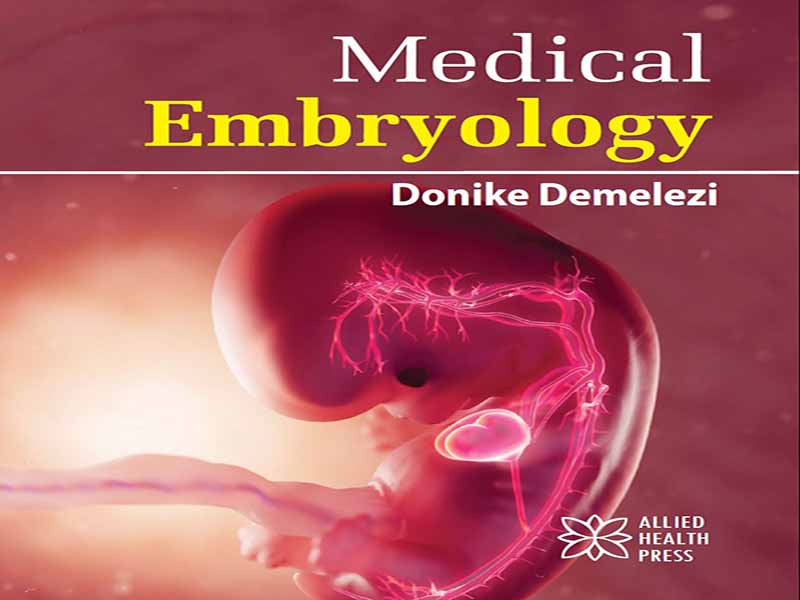- عنوان کتاب: Medical Embryology
- نویسنده: Donike Demelezi
- حوزه: جنین شناسی
- سال انتشار: 2025
- تعداد صفحه: 315
- زبان اصلی: انگلیسی
- نوع فایل: pdf
- حجم فایل: 6.06 مگابایت
جنینشناسی بالینی یک رشته پیشرفته است که مطالعه جنینشناسی را با فناوریهای کمک باروری (ART) پیوند میدهد. این رشته در درجه اول بر پیچیدگیهای رشد انسان از زمان لقاح تا مراحل اولیه بارداری، به ویژه در زمینه درمانهای باروری، تمرکز دارد. دامنه جنینشناسی بالینی طیف گستردهای از تکنیکها و فرآیندهایی را در بر میگیرد که برای کمک به لقاح و تضمین سالمترین شروع ممکن برای جنینهای انسان طراحی شدهاند. در هسته جنینشناسی بالینی، روشهای آمادهسازی و تجزیه و تحلیل اسپرم قرار دارند. این مراحل، مراحل مهمی در ارزیابی زنده ماندن و کیفیت اسپرم برای استفاده در تکنیکهای کمک باروری مانند لقاح آزمایشگاهی (IVF) و تزریق داخل سیتوپلاسمی اسپرم (ICSI) هستند. این روشها در انتخاب بهترین اسپرم ممکن برای لقاح، با هدف افزایش شانس بارداری موفق، اساسی هستند. یکی دیگر از جنبههای مهم جنینشناسی بالینی، فرآیند تلقیح مورد استفاده در درمانهای IVF و ICSI است. این شامل معرفی دقیق اسپرم به تخمک (تخمک) برای تسهیل لقاح است. پس از لقاح، جنینشناسان ارزیابی جنینها را انجام میدهند. این ارزیابی میتواند با استفاده از تکنیکهای ارزیابی مورفولوژیکی سنتی یا با کمک فرآیندهای پیشرفتهتر انجام شود. در میان این روشها، تصویربرداری مرور زمان به عنوان تکنیکی که امکان نظارت مداوم بر رشد جنین را فراهم میکند، دادههای ارزشمندی در مورد الگوهای رشد و قابلیت حیات جنین ارائه میدهد. متابولومیکس، مطالعه فرآیندهای شیمیایی شامل متابولیتها، و اندازهگیری میکرو RNAها (miRNAها) با استفاده از روشهای محاسباتی، بینش عمیقی در مورد سلامت و پتانسیل رشد جنین ارائه میدهد، فراتر از آنچه که میتوان از طریق ارزیابی بصری به تنهایی تشخیص داد. این حوزه همچنین شامل انجماد سریع (انجماد سریع) و ذوب گامتها (اسپرم و تخمک) و جنینها میشود. این فرآیند برای حفظ این سلولها برای استفاده در آینده، بدون به خطر انداختن قابلیت حیات آنها، ضروری است. تکنیکها و پروتکلهای انجماد و ذوب به طور مداوم اصلاح میشوند تا بالاترین میزان بقای ممکن را تضمین کرده و یکپارچگی گامتها و جنینها را حفظ کنند. کنترل و تضمین کیفیت در آزمایشگاههای جنینشناسی از اهمیت بالایی برخوردار است. این پروتکلها تضمین میکنند که تمام مراحل تحت شرایط بهینه انجام میشوند تا شانس موفقیت به حداکثر برسد. این شامل حفظ محیطهای استریل، اطمینان از عملکرد صحیح تجهیزات و رعایت پروتکلهای سختگیرانه برای جابجایی گامتها و جنینها میشود. در سالهای اخیر، تأکید قابل توجهی بر لزوم ارزیابی کیفیت جنینها قبل از انتقال شده است. این امر برای بهبود میزان موفقیت روشهای ART بسیار مهم است. علاوه بر این، پروتکلهای تحریک مورد استفاده برای القای تولید تخمکها به دقت تنظیم شدهاند تا با نیازهای خاص هر بیمار مطابقت داشته باشند. این رویکرد شخصیسازی شده به درمان باروری، کیفیت تخمکها و جنینهای بعدی را به طور قابل توجهی بهبود بخشیده و این فرآیند را با پاسخ فیزیولوژیکی فرد به داروهای تحریککننده تطبیق میدهد. فراتر از جنبههای فنی و رویهای، جنینشناسی بالینی و پزشکی تولید مثل نیز با مسائل پیچیده اخلاق زیستی روبرو هستند. از آنجایی که این حوزه شامل دستکاری گامتها و جنینهای مرحله قبل از لانهگزینی است، ملاحظات اخلاقی عمیقی وجود دارد که باید به آنها پرداخته شود. این موارد شامل پیامدهای اخلاقی انتخاب جنین، دفع جنینهای بلااستفاده و احتمال تغییرات ژنتیکی است. این حوزه دائماً با این مسائل دست و پنجه نرم میکند و تلاش میکند تا پتانسیل باورنکردنی فناوریهای کمک باروری را با اصول اخلاقی و ارزشهای اجتماعی متعادل کند. این کتاب، کاوشی عمیق در مورد رشد انسان از لقاح تا تولد ارائه میدهد و بر مفاهیم بنیادی و آخرین پیشرفتها در زمینه جنینشناسی تمرکز دارد. این کتاب به گونهای طراحی شده است که شکاف بین دانش پایه جنینشناسی و کاربردهای بالینی آن را پر کند و در نتیجه درک فرآیندهای رشد انسان و ناهنجاریهای مادرزادی را افزایش دهد. این متن مراحل رشد انسان، مکانیسمهای سلولی و مولکولی دخیل و اساس جنینشناسی بیماریهای مختلف پزشکی را با هدف تجهیز دانشجویان پزشکی، متخصصان مراقبتهای بهداشتی و محققان به درک جامعی از موضوع، به تفصیل شرح میدهد. این کتاب به عنوان یک منبع آموزشی و یک راهنمای مرجع، در خدمت دانشجویان پزشکی، رزیدنتهای اطفال، زنان و زایمان و همچنین متخصصان پزشکی تولید مثل و زیستشناسی رشد خواهد بود. این کتاب از طریق تصاویر واضح، متن بهروز و همبستگیهای بالینی، تلاش میکند تا دانش خواننده را غنی کند و به کاربردهای تشخیصی و درمانی مرتبط با جنینشناسی کمک کند. این کتاب به ویژه برای کسانی که به دنبال درک پیچیدگیهای رشد انسان، درک ریشههای ناهنجاریهای مادرزادی و به کارگیری دانش جنینشناسی در عمل بالینی برای بهبود مراقبت از بیمار هستند، ارزشمند است.
Clinical embryology is an advanced field that intersects the study of embryology with assisted reproductive technologies (ART). This discipline primarily focuses on the intricacies of human development from conception to the early stages of pregnancy, specifically within the context of fertility treatments. The scope of clinical embryology encompasses a broad range of techniques and processes designed to assist in the conception and ensure the healthiest possible start for human embryos. At the core of clinical embryology are sperm preparation and analysis procedures. These are critical steps in assessing the viability and quality of sperm for use in assisted reproductive techniques such as in vitro fertilization (IVF) and intracytoplasmic sperm injection (ICSI). These procedures are fundamental in selecting the best possible sperm for fertilization, aiming to increase the chances of successful pregnancy. Another crucial aspect of clinical embryology is the insemination process used in IVF and ICSI treatments. This involves carefully introducing sperm to the oocyte (egg) to facilitate fertilization. Following fertilization, embryologists undertake the evaluation of the embryos. This evaluation can be performed using traditional morphological assessment techniques or with the aid of more advanced processes. Among these, time-lapse imaging stands out as a technique that allows continuous monitoring of embryo development, providing invaluable data on the embryo’s growth patterns and viability. Metabolomics, the study of chemical processes involving metabolites, and the measurement of microRNAs (miRNAs) using computational methods, offer deep insights into the health and development potential of embryos, beyond what can be discerned through visual assessment alone. The field also involves the vitrification (fast freezing) and thawing of gametes (sperm and eggs) and embryos. This process is essential for preserving these cells for future use, without compromising their viability. The techniques and protocols for freezing and thawing are continuously refined to ensure the highest possible survival rates and maintain the integrity of the gametes and embryos. Quality control and assurance within embryology laboratories are paramount. These protocols ensure that all procedures are conducted under optimal conditions to maximize the chances of success. This includes maintaining sterile environments, ensuring equipment is functioning correctly, and adhering to strict protocols for handling gametes and embryos. In recent years, there has been a significant emphasis on the need to assess the quality of embryos before transfer. This is crucial for improving the success rates of ART procedures. Additionally, the stimulation protocols used to induce the production of oocytes have been finely tuned to match the specific needs of each patient. This personalized approach to fertility treatment has significantly improved the quality of oocytes and subsequent embryos, tailoring the process to the individual’s physiological response to stimulate medications. Beyond the technical and procedural aspects, clinical embryology and reproductive medicine also navigate complex bioethical issues. Since the field involves the manipulation of gametes and preimplantation stage embryos, there are profound ethical considerations to be addressed. These include the moral implications of embryo selection, the disposal of unused embryos, and the potential for genetic modifications. The field constantly grapples with these issues, striving to balance the incredible potential of assisted reproductive technologies with ethical principles and societal values. This book provides an in-depth exploration of human development from conception through to birth, focusing on the fundamental concepts and latest advancements in the field of embryology. It is designed to bridge the gap between basic embryological knowledge and its clinical applications, thereby enhancing the understanding of human developmental processes and congenital anomalies. The text details the stages of human development, the cellular and molecular mechanisms involved, and the embryological basis of various medical conditions, aiming to equip medical students, healthcare professionals, and researchers with a comprehensive understanding of the subject. The book will serve medical students, residents in pediatrics, obstetrics, and gynecology, as well as professionals in reproductive medicine and developmental biology as both an educational resource and a reference guide. Through clear illustrations, up-to-date text, and clinical correlates, it endeavors to enrich the reader’s knowledge, aiding in diagnostic and therapeutic applications related to embryology. This book is particularly valuable for those seeking to grasp the complexities of human development, understand the origins of congenital anomalies, and apply embryological knowledge in clinical practice to improve patient care.
این کتاب را میتوانید بصورت رایگان از لینک زیر دانلود نمایید.
Download: Medical Embryology



































نظرات کاربران